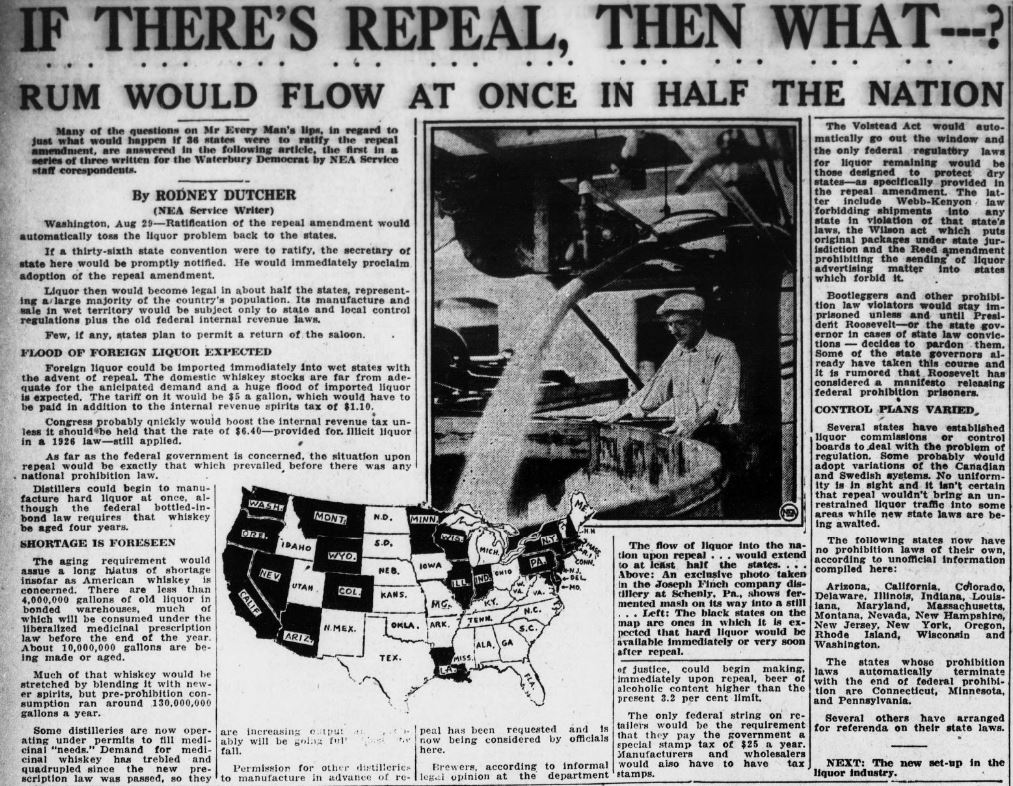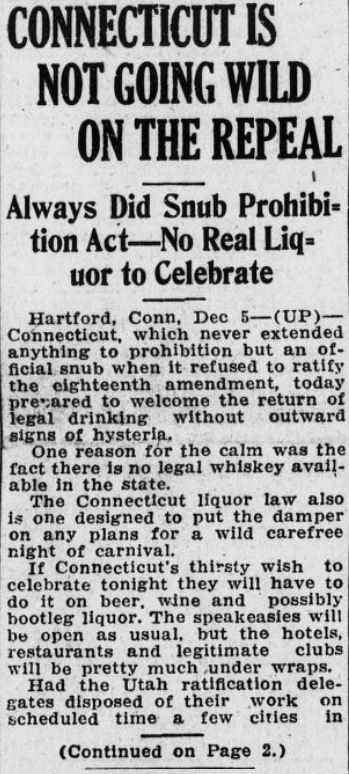Prohibition in the United States: A 100-Year Retrospective – Repeal, Taxation, and What Followed
Prohibition in the United States: A 100-Year Retrospective is a 5-part blog series offering readers an overview of the history of drug prohibition in the United States using historical newspapers and two of the nation’s most widely used psychoactive drugs: alcohol and marijuana. Part 5, “Repeal, Taxation, and What Followed,” wraps up the series by comparing the cost of drug enforcement with tax revenue following legalization, and discusses what happened when the 18th Amendment was repealed. This post also includes the series bibliography. Thank you for reading!
Repeal, Taxation, and What Followed
In the last analysis, my friends, the Prohibition issue comes down to a question of faith and confidence in leadership and in the words of leaders. […] All will join in condemning a fearful and timid practice of evasion.
Franklin Delano Roosevelt, 1932
The cause to repeal the 18th Amendment, like the movement for the 18th Amendment, was championed by women. By the late 1920s, the ideals of the temperance movement had been complicated by the violence and corruption of Prohibition in practice. Pauline Morton Sabin, a prominent political activist and socialite, established the Women’s Organization for National Prohibition Reform (WONPR) in 1929, an organization that garnered 1.5 million members by 1931 (three times that of the Woman’s Christian Temperance Union at the height of its membership). Sabin’s connection with the temperance movement of the 1910s, paired with her charming personality and positive public perception of her character, empowered morally “dry” former Prohibition supporters to question the efficacy of the 18th amendment in the face of its negative impact on society. In 2023, the WONPR has been revived, and has shifted their advocacy efforts to marijuana legislation reform, among other issues.
Prohibition cost the federal government an estimated $300 billion in enforcement, and $11 billion in would-be tax revenue. The Great Depression opened the door for repeal, as it was more financially practical for the Federal Government to legalize and tax alcohol than it was to keep paying the high cost of ineffective enforcement. In 1934, the first full year of legal, taxed alcohol following the Prohibition era, tax revenue from spirits, wines, and fermented malt liquors totaled $5.8 billion, adjusted for inflation ($258,912,000 in 1934). In a 1932 campaign speech on the issue, Franklin Delano Roosevelt said:
The time of depression has caused us to see even more plainly than before not only the political and moral consequences of our action but its economic results as well. […] Unquestionably our tax burden would not be so heavy nor the forms that it takes so objectionable if some reasonable proportion of the uncounted millions now paid to those whose business has been reared upon this stupendous blunder could be made available for the expenses of the government.
The Budgetary Implications of Marijuana Prohibition in the United States was a 2005 report detailing the costs of marijuana prohibition and the potential tax revenue that might be generated by its legalization. The accompanying petition was signed by over 500 economists, 3 of them Nobel Laureates, in an effort to draw the attention of “the President, Congress, Governors, and State Legislatures” to the document. The report estimated that marijuana enforcement (in 2005 money) was costing the federal government $7.7 billion annually, and its legalization had the potential to earn $2.4 billion in tax revenue if taxed like most goods, or $6.2 billion if taxed like alcohol or tobacco.
As for American drinking, very little changed between the last years of Prohibition and the first years after repeal, counter to predictions by politicians and news media at the time. Ironically, due to regulations on alcohol’s manufacture and sale (e.g., age limits, closing hours) as set by the 21st Amendment and state-by-state laws, drinking became more restricted following repeal. A 1991 piece for the American Economic Review estimated that American drinking dropped sharply at the outset of Prohibition, to around 30% of where it had been, rose gradually to about 60-70% of pre-Prohibition levels over the course of the era, and remained there immediately following repeal. Over the decade that followed, drinking gradually rose to pre-Prohibition levels again. The authors speculated that because legal deterrents, social pressure, expense, and respect for the law seemed to have a negligible impact on alcohol consumption during and following Prohibition, the same is likely to be true regarding the legalization of other illegal drugs. The end of Prohibition in the early 1930s made way for a new public awareness of the risks of alcohol use and abuse, however, and some of those living with alcoholism began to find help through support groups like Alcoholics Anonymous, which was founded in 1935.
References
67 Congress. Supplemental to the National Prohibition Act. 67–96, 1921.
100th Congress. Anti-Drug Abuse Act of 1988. 100–690, 18 Nov. 1988, https://www.congress.gov/bill/100th-congress/house-bill/5210/text.
ACLU. The War on Marijuana in Black and White. ACLU, June 2013, https://www.aclu.org/report/report-war-marijuana-black-and-white?redirect=criminal-law-reform/war-marijuana-black-and-white.
An Analysis of Marijuana Policy. National Research Council (US) Committee on Substance Abuse and Habitual Behavior, 14 July 1982, https://www.ncbi.nlm.nih.gov/books/NBK217615/.
Anderson, D. Mark. “Medical Marijuana Laws, Traffic Fatalities, and Alcohol Consumption.” The Journal of Law & Economics, vol. 56, no. 2, May 2013, pp. 333–69, https://www.jstor.org/stable/10.1086/668812.
Appel, Jacob M. “‘Physicians Are Not Bootleggers’: The Short, Peculiar Life of the Medicinal Alcohol Movement.” Bulletin of the History of Medicine, vol. 82, no. 2, Summer 2008, pp. 355–86, https://www.jstor.org/stable/44448552.
Baum, Dan. “Legalize It All.” Harper’s, Apr. 2016, https://harpers.org/archive/2016/04/legalize-it-all/.
Bevan, Arthur Dean. “Prescribing of Alcoholic Liquors By Physicians – a Statement By Dr. Arthur Dean Bevan.” Journal of the American Medical Association, Apr. 1932, p. 1494, https://jamanetwork.com/journals/jama/article-abstract/279459.
Boyd, Jennifer, and Sara Conner. Prohibition: Connecticut Goes Dry. Connecticut Public Broadcasting, Inc., 2012, https://www.youtube.com/watch?v=0oZn6jFeypw.
Bridgeman, Mary Barna, and Daniel T. Abazia. “Medicinal Cannabis: History, Pharmacology, And Implications for the Acute Care Setting.” Pharmacy and Therapeutics, vol. 42, no. 3, Mar. 2017, pp. 180–88, https://www.ncbi.nlm.nih.gov/pmc/articles/PMC5312634/.
Chalmers, David. “The Ku Klux Klan In Politics In The 1920’s.” Mississippi Quarterly, vol. 18, no. 4, Fall 1965, pp. 234–47.
Christiansen, Matthew A. “A Great Schism: Social Norms and Marijuana Prohibition.” Harvard Law & Policy Review, vol. 4, Feb. 2010, p. 229, https://harvardlpr.com/wp-content/uploads/sites/20/2013/05/4.1_11_Christiansen.pdf.
“Darrow Says He Opposes Prohibition.” The Fiery Cross, 7 Nov. 1924, p. 2, https://newspapers.library.in.gov/?a=d&d=FC19241107.1.2&e=——-en-20–1–txt-txIN——-.
Eschner, Kat. “Why the Ku Klux Klan Flourished Under Prohibition.” Smithsonian, 5 Dec. 2017, https://www.smithsonianmag.com/smart-news/why-racism-flourished-under-prohibition-180967406/.
Goldfarb, Aaron. “Tour a Collection of Prohibition-Era ‘Medicinal’ Whiskey.” Punch Drink, 1 May 2018, https://punchdrink.com/articles/tour-collection-prohibition-era-medicinal-vintage-whiskey-bottles/.
Gottlieb, Scott. Statement from FDA Warning about Significant Health Risks of Contaminated Illegal Synthetic Cannabinoid Products That Are Being Encountered by FDA. Food and Drug Administration, 19 July 2018, https://www.fda.gov/news-events/press-announcements/statement-fda-warning-about-significant-health-risks-contaminated-illegal-synthetic-cannabinoid.
Graham, Fred P. “National Commission to Propose Legal Private Use of Marijuana.” The New York Times, 13 Feb. 1972, pp. 1, 61, https://timesmachine.nytimes.com/timesmachine/1972/02/13/issue.html.
Hartford, Tim. “What Prohibition’s Failure Means for the Legalisation of Cannabis.” BBC News, 23 Oct. 2019, https://www.bbc.com/news/business-49906476.
“History.” Women Ending Prohibition, https://womenendingprohibition.org/history/.
Jurkiewicz, Carole. Social and Economic Control of Alcohol: The 21st Amendment in the 21st Century. 1st ed., Routledge, 2007.
K2/Spice Drug Fact Sheet. Department of Justice, Drug Enforcement Administration, Oct. 2022.
“Ku Klux Klan Raid (Inglewood, California).” Wikipedia, 25 Apr. 2023, https://en.wikipedia.org/w/index.php?title=Ku_Klux_Klan_raid_(Inglewood,_California)&action=history.
Kyvig, David E. “Women Against Prohibition.” American Quarterly, vol. 28, no. 4, Autumn 1976, p. 468, https://doi.org/https://doi.org/10.2307/2712541.
“Legal History of Cannabis in the United States.” Wikipedia, https://en.wikipedia.org/wiki/Legal_history_of_cannabis_in_the_United_States.
Lerner, Michael. “Unintended Consequences of Prohibition.” PBS, https://www.pbs.org/kenburns/prohibition/unintended-consequences.
“Marijuana and Public Health, Data and Statistics.” Centers for Disease Control and Prevention, 8 June 2021, https://www.cdc.gov/marijuana/data-statistics.htm.
Massaro, Mike. “One Year Later: K2 Overdoses on the New Haven Green.” NBC Connecticut, 15 Aug. 2019, https://www.nbcconnecticut.com/news/local/one-year-later-new-haven-k2-overdose/123091/.
McGirr, Lisa. “How Prohibition Fueled the Klan.” NYTimes, 16 Jan. 2019, https://www.nytimes.com/2019/01/16/opinion/prohibition-immigration-klan.html.
“Medical Marijuana Statistics.” Connecticut State Department of Consumer Protection, 7 June 2023, https://portal.ct.gov/DCP/Medical-Marijuana-Program/Medical-Marijuana-Statistics.
Mejia, Paula. “Gastro Obscura: The Lucrative Business of Prescribing Booze During Prohibition.” Atlas Obscura, 15 Nov. 2017, https://www.atlasobscura.com/articles/doctors-booze-notes-prohibition.
Miron, Jeffrey A., and Jeffrey Zwiebel. “Alcohol Consumption During Prohibition.” The American Economic Review, vol. 81, no. 2, May 1991, pp. 242–47.
National Academies of Sciences, Engineering, and Medicine, et al. “15, Challenges and Barriers in Conducting Cannabis Research.” The Health Effects of Cannabis and Cannabinoids: The Current State of Evidence and Recommendations for Research, 1st ed., National Academies Press (US), 2017, https://www.ncbi.nlm.nih.gov/books/NBK425757/.
National Conference of State Legislatures. “State Medical Cannabis Laws.” NCSL, 24 Apr. 2023, https://www.ncsl.org/health/state-medical-cannabis-laws.
Norris, Charles. “Our Essay in Extermination.” The North American Review, vol. 226, no. 6, Dec. 1928, pp. 645–52, https://www.jstor.org/stable/i25110629.
Ofgang, Eric. “100 Years Ago, Poison Alcohol Turned Hartford Christmas Celebrations Deadly.” CT Insider, 20 Nov. 2019, https://www.ctinsider.com/connecticutmagazine/news-people/article/100-years-ago-poison-alcohol-turned-Hartford-17044944.php.
Okrent, Daniel. Last Call: The Rise and Fall of Prohibition. Scribner, 2011, https://www.amazon.com/Last-Call-Rise-Fall-Prohibition/dp/074327704X.
Onion, Rebecca. “A New History of Prohibition.” Slate, 11 Dec. 2015, https://slate.com/news-and-politics/2015/12/prohibition-history-how-the-ban-on-booze-produced-the-modern-american-right.html.
“Pauline Sabin.” Wikipedia, https://en.wikipedia.org/wiki/Pauline_Sabin.
Peck, Garrett. “For Marijuana Legalization, Lessons From Prohibition.” The New York Times, 22 May 2013, https://www.nytimes.com/roomfordebate/2013/05/22/how-can-marijuana-be-sold-safely/for-marijuana-legalization-lessons-from-prohibition.
Pegram, Thomas R. “Hoodwinked: The Anti-Saloon League and the Ku Klux Klan in 1920s Prohibition.” The Journal of the Gilded Age and Progressive Era, vol. 7, no. 1, Jan. 2008, pp. 89–119, https://www.jstor.org/stable/25144510.
Penaloza, Marisa. “America’s Synthetic Marijuana Overdose Crisis, Explained.” NPR, 27 July 2018, https://www.npr.org/2018/07/27/632261920/d-c-has-had-more-than-300-suspected-k2-overdoses-in-2-weeks.
Roper, Daniel C., and Claudius T. Murchinson. Statistical Abstract of the United States 1935, National Government Finances. U.S. Department of Commerce, 1935.
Rothman, Joshua D. “When Bigotry Paraded Through the Streets.” The Atlantic, 4 Dec. 2016, https://www.theatlantic.com/politics/archive/2016/12/second-klan/509468/.
Rothman, Lily. “The History of Poisoned Alcohol Includes an Unlikely Culprit: The U.S. Government.” Time Magazine, 14 Jan. 2015, https://time.com/3665643/deadly-drinking/.
Sacco, Lisa N., et al. The Federal Status of Marijuana and the Expanding Policy Gap with States. IF12270, Congressional Research Service, 6 Mar. 2023.
Segal, David. “When Capitalism Meets Cannabis.” The New York Times, Online, 26 June 2010, https://www.nytimes.com/2010/06/27/business/27pot.html.
Siff, Stephen. “The Illegalization of Marijuana: A Brief History.” Origins: Current Events in Historical Perspective, May 2014, https://origins.osu.edu/article/illegalization-marijuana-brief-history?language_content_entity=en.
“U.S. Marshals Role During Prohibition.” U.S. Marshals, https://www.usmarshals.gov/who-we-are/history/historical-reading-room/us-marshals-role-during-prohibition.
Volstead, Andrew. The Volstead Act. 66–66, 28 Oct. 1919, https://www.loc.gov/rr/main/images/volstead-act.pdf.
Watkins, Meredith. “What Can Marijuana Be Laced With?” American Addiction Centers, 7 Sept. 2022.
Waxman, Olivia B. “Why the Repeal of Prohibition Actually Made It Harder to Get a Drink.” Time, 5 Dec. 2018, https://time.com/5469508/prohibition-repeal-anniversary-history/.
“Yes, The U.S. Gov’t Poisoned Alcohol in the 1920s.” Drinks, Crime, and Prohibition, 1, Smithsonian Channel, 2018, https://www.youtube.com/watch?v=CWo8vNRbPyQ.


